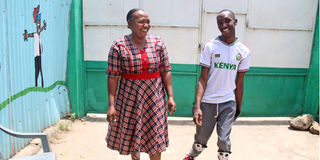Cerebral palsy didn't stop him from going to college, getting a job

What you need to know:
- There is no cure for the condition but patients can be managed and lead meaningful lives.
- When complications occur during delivery, sometimes resulting in the baby not crying spontaneously at birth, it could signal a risk for cerebral palsy.
- Other risk factors include pre-term delivery, prolonged labour, and neonatal jaundice.
On April 12, 1998, Catherine Nthenya went into labour for about 27 hours, giving birth to Nicholas Ndambuki, now 22. Apart from the long labour, the delivery had another puzzling event. The baby did not cry like he should.
“I had to stay in the hospital for one month for my baby to be closely monitored. He was not breastfeeding and cried uncontrollably every night,” she tells HealthyNation.
The incident ushered in a lifelong disability – cerebral palsy. “After three months of raising my son, he still appeared weaker than babies his age,” says Catherine.
In his ninth month, she took him to Kenyatta National Hospital after noticing that her child’s weight had been static.
When Nicholas turned one the following year, he could stand but not properly. He was diagnosed with cerebral palsy.
“They started giving him therapy at the hospital immediately they learnt of his condition. The doctors told me if the condition is properly managed my son could still live long,” she recalls.
“I had to quit my job as a casual labourer at EPZ to take care of my son,” she adds, a decision she does not regret. Around the same time, an NGO was opened near their home and she took Nicholas there for therapy.
When he turned two and a half years old, he started speaking, but with difficulty.
Little data
A year later, his walking improved and his mother took him to school. Unlike most people who with cerebral palsy, Nicholas does not suffer seizures.
“From the onset, I never was of the idea of taking my son to a special school. I did not want him to feel alienated from society,” she tells HealthyNation.
Nicholas, because of the love he received throughout his life, managed to enrol in a college to study graphic design and is now an intern at the Cerebral Palsy Society of Kenya (CPSK).
In Kenya, four of 10 people are completely unaware of any special school admitting children with cerebral palsy, shows data from CPSK.
Seven in 10 children with cerebral palsy are below 12 years, says CPSK. “Do not lock up your child in the house because of their condition,” advises his mother.
“If you have children who have a condition like his, do not think of them as a burden. If you take care of them with love, the child will improve and be a useful member of the society.”
Consultant paediatrician, Dr Ambrose Agweyu, explains that cerebral palsy is a group of conditions and is not a single disease.
“The hallmark of cerebral palsy is injury to the brain while it is still developing,” he says. “All the conditions leading to cerebral palsy relate to some form of injury to the brain that could occur before, during or soon after birth.”
However, he says there is a small group of children who may be born healthy and subsequently, develop a brain infection that could then cause long-term consequences including cerebral palsy.
Prolonged labour
Unfortunately, there is no cure for the condition but patients can be managed and lead meaningful lives.
The condition varies in degree of severity and the milder forms are easier to be managed compared to more severe forms.
Dr Agweyu explains that when complications occur during delivery, sometimes resulting in the baby not crying spontaneously at birth, it could signal a risk for cerebral palsy.
Other risk factors include pre-term delivery, prolonged labour, and neonatal jaundice.
There are different manifestations depending on the age of the child, but one of the unifying characteristics is the delay in achieving milestones.
“The management ranges from non-pharmaceutical approaches like physiotherapy to use of drugs,” he says. Children with cerebral palsy need therapy at least three times in a week.
The cost of therapy in private hospitals could be about Sh3, 000 or more per session while government hospitals charge Sh500 or slightly less per session.
According to a research by CPSK, most insurances do not cover for therapy.
Cerebral Palsy Awareness Month is marked in March.



